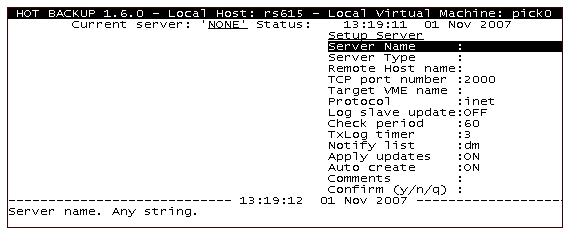Setup Server utility
The Setup Server utility displays automatically the first time Hot Backup is installed, or by selecting the Setup Server option from the Special Operations menu. This utility creates and configures servers.

| Field | Description |
|---|---|
| Server Name | Name for the server. This name references the server in all the other menus. If there is only one server defined on the D3 virtual machine, this server is implied in all commands. |
| Server Type | Specifies whether the server is to be the master or the slave
server. m = master s = slave |
| Remote Host name | Name of the UNIX host where the associated slave server is
located. Can also be the IP address of the remote host. The master
and slave servers should both be set to the same value. Note: To ensure
that you use the correct host name or IP address, use the UNIX ping command from a UNIX prompt to ensure that you can
communicate with the remote host. For example:
ping [ hostname| IP Address] |
| TCP port number |
Note: You can use the UNIX netstat command
to locate a free port number. The required options for netstat are different per UNIX platform. Please consult the UNIX documentation
for your system to obtain the correct options.
|
| Target VME name | For master servers only. Name of the VME server on the slave machine. |
| Protocol | inet. Cannot be modified. |
| Log slave update | For slave servers only. This option is for Hot Backup implementations that include multiple cascading servers. If set to ON, all updates the slave receives are logged in the transaction log queue, to be sent to another system. If set to OFF, the updates are not enqueued. The default is OFF. |
| Check period | For master servers only. The master server routinely performs a variety of system tests. This value represents the time (in seconds) to wait between tests. For example, if set to 60, a test record is sent every 60 seconds to the slave server to ensure the link is functioning. If no response returns from the slave server, it reports an error. A value of 0 disables all tests. A period of 300 seconds (5 minutes) is suitable for most systems. |
| TxLog timer | For master servers only. Time (in seconds) the master server waits (after emptying the transaction log queue) to restart the process of emptying the transaction log queue again. A value of two or three seconds is suitable. |
| Notify list | List of D3 users (as defined in the D3 users file) or D3 port numbers to notify in case of error, separated by
commas. The port numbers are expressed in a syntax similar to the
TCL command msg. For example, to notify the
users dm and bob, and line 0 (regardless of whether it is logged on): dm,bob,!0 |
| Apply updates | For slave servers only. Instructs the slave server to apply
the updates it receives from the master server immediately (ON) or delay them (OFF) until
it receives an explicit command. Normally, this option should be set
to ON. Note: When the slave server starts,
it reports the status of this option. Applying updates should not
be disabled long, since the slave and master databases can be become
out-of-sync when updates are not applied.
|
| Auto create | For slave servers only. Automatically creates any missing
accounts and files on the slave server. Note: It is a good precaution
to leave this option set to ON.
|
| Comments | Any comments. |